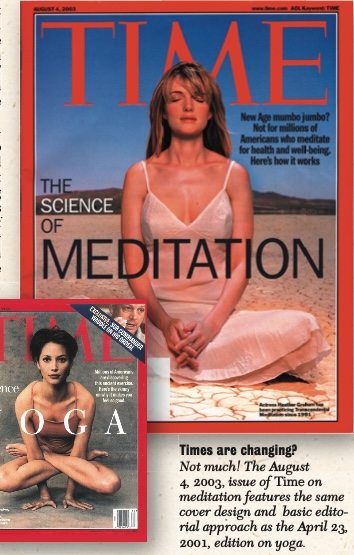Let there be no confusion. the primary aim of meditation is spiritual evolution. Not surprisingly, such a lofty goal appeals only to the rare few. If Joel Stein’s Time magazine feature article entitled “Just Say Om ” yields some indication of what most people want from this ancient contemplative art, any sort of evolution at all is far down the list. Still, the subject is there right on the cover of Time, even referred to with dignity as the “Science of Meditation.” And science is the key word here. Much of the article has to do with proving the benefits of meditation scientifically.
From Stein’s point of view, meditation is most beneficial as a means to good health physical, emotional and mental, in that order. Apparently, a lot of people agree with him. According to Stein, ten million American adults now say they practice some form of meditation regularly, twice as many as a decade ago, and mainly for health benefits. At least that’s what they are telling interviewers.
“Contentment and inner peace are nice, ” says Stein. “But think how many Americans would start meditating if you could convince them they would live longer because of it.”
Meditation classes are now being offered in schools, hospitals, law firms, prisons, governmental and corporate offices even airports. West Point Naval Academy offers a course on meditation.
This escalating popularity of such an ancient art is most certainly fueled by the fact that many meditators are famous.
Goldie Hawn, Shania Twain, Heather Graham, Richard Gere and Al Gore all meditate. So does Bill Ford, the head of Ford Motors. Even Hillary Clinton has talked about learning to meditate.
Except for a few unnecessarily sarcastic comments like “Meditators no longer have to go off to some bearded guru in the woods ” and “Meditation has become the smart man’s bubble bath, ” Stein’s report is positive. He concedes that “non-believers are becoming the minority, ” and does well in not only listing health benefits of meditation but also in providing scientific data from current studies that validate them.
“Recent studies show that meditation can boost the immune system, ” he says. “The current interest is as much medical as it is cultural. Meditation is being recommended by physicians as a way to prevent, slow or at least control the pain of chronic diseases like heart conditions, AIDS, cancer and infertility. What’s exciting about the new research is how meditation can train the mind and reshape the brain. Tests using the most sophisticated imaging techniques suggest that it can actually reset the brain.”
All of this is quite impressive to those who don’t know anything about meditation. But for those who do, there is something seriously missing from the report. Howard Beckman, Director of the Vedic Cultural Fellowship in New Mexico says, “I suppose you could call this article positive in that it does not try to ‘debunk’ meditation as a practice, but it is extremely shallow and really misses the point of why we meditate. Meditation is a yogic practice aimed at self-realization and gaining greater ability to advance spiritually, not simply a practice to combat material stress and anxiety.”
Chamundi Sabanathan, a serious student of meditation, agrees completely, but speculates that perhaps the shallow focus was an editorial decision. “I think the author’s main purpose was to establish a rapport with people who might not otherwise read this article, ” says Chamundi. “Perhaps he was operating under the belief (or perhaps the editorial dictum) that he had to either make it light and funny, or lose his readers.”
Although much of Stein’s material was drawn from TM (Transcendental Meditation) studies, tests and practices, even long-time TM practitioners were not entirely happy with the article.
Ken Chawkin, Media Relations Officer for the Maharishi University in Fairfield, Iowa, where TM is taught, shared with Hinduism Today that “the topic was superficially handled…. The technique Time gave in a sidebar suggested that one can learn meditation from an article and get all the benefits mentioned in the article. That sort of thing is very misleading and could give sincere seekers the wrong impression.”
Concerning a somewhat sexy photograph in the article of Heather Graham, a TM meditator since 1991, Beckman said, “[The picture] evokes more a feeling of physical sexuality than a spiritual mood or contemplative state of consciousness. [It] does not at all instill a feeling that this is something serious.”
Heather Graham is also on the magazine’s cover. Two years ago, when Christy Turlington appeared on the cover of Time in the very same design lay-out (see photo), Hinduism Today reported on it then, too (September/October, 2001). Then it was the “Science of Yoga.” Now it is the “Science of Meditation.” Tomorrow who knows. Certainly, time will tell.
